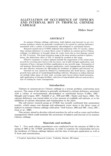Alleviation of Occurrence of Tipburn and Internal Rot in Tropical Chinese Cabbage
Tropical agriculture research series : proceedings of a symposium on tropical agriculture researches
| ISSN | 03889386 |
|---|---|
| 書誌レコードID(総合目録DB) | AA00870529 |

本文フルテキスト
tars23-_203-217.pdf2.07 MB
In summer Chinese cabbage cultivation, both tipburn and internal rot are very serious problems which are generally considered to be caused by calcium deficiency associated with a variety of environmental, physiological or nutritional factors.
Research carried out at AVRDC indicates that ammonia (NH4-N) toxicity, rather than calcium deficiency is a more direct cause of tipburn in summer-grown Chinese cabbage. Ca deficiency is brought about by water stress due to root damage caused by NH4-N toxicity. The head formation stage is the most sensitive period to tipburn ; hence, the deleterious effect of NH4-N should be avoided at this stage.
Effective measures to reduce tipbum include the suppression of the initial plant growth by covering outer leaves with rice straw, use of split nitrogen application, and omission of heavy nitrogen fertilizer application at any growth stage. Attenuation of soil moisture fluctuations by compost application, water management and mulching are also effective measures for alleviating the incidence of tipburn and internal rot.
Internal rot was caused by limited Ca translocation into head leaves, vigorous growth rates and use of round-shaped heading cultivars. Measures to reduce internal rot include foliar spray of citric acid, covering outer leaves before head formation, split application of nitrogen fertilizer, selection of long-headed cultivars and acceleration of rooting by water management.
Research carried out at AVRDC indicates that ammonia (NH4-N) toxicity, rather than calcium deficiency is a more direct cause of tipburn in summer-grown Chinese cabbage. Ca deficiency is brought about by water stress due to root damage caused by NH4-N toxicity. The head formation stage is the most sensitive period to tipburn ; hence, the deleterious effect of NH4-N should be avoided at this stage.
Effective measures to reduce tipbum include the suppression of the initial plant growth by covering outer leaves with rice straw, use of split nitrogen application, and omission of heavy nitrogen fertilizer application at any growth stage. Attenuation of soil moisture fluctuations by compost application, water management and mulching are also effective measures for alleviating the incidence of tipburn and internal rot.
Internal rot was caused by limited Ca translocation into head leaves, vigorous growth rates and use of round-shaped heading cultivars. Measures to reduce internal rot include foliar spray of citric acid, covering outer leaves before head formation, split application of nitrogen fertilizer, selection of long-headed cultivars and acceleration of rooting by water management.
| 刊行年月日 | |
|---|---|
| 作成者 | Hideo Imai |
| 公開者 | Japan International Research Center for Agricultural Sciences |
| 巻 | 23 |
| 開始ページ | 203 |
| 終了ページ | 217 |
| 言語 | eng |
